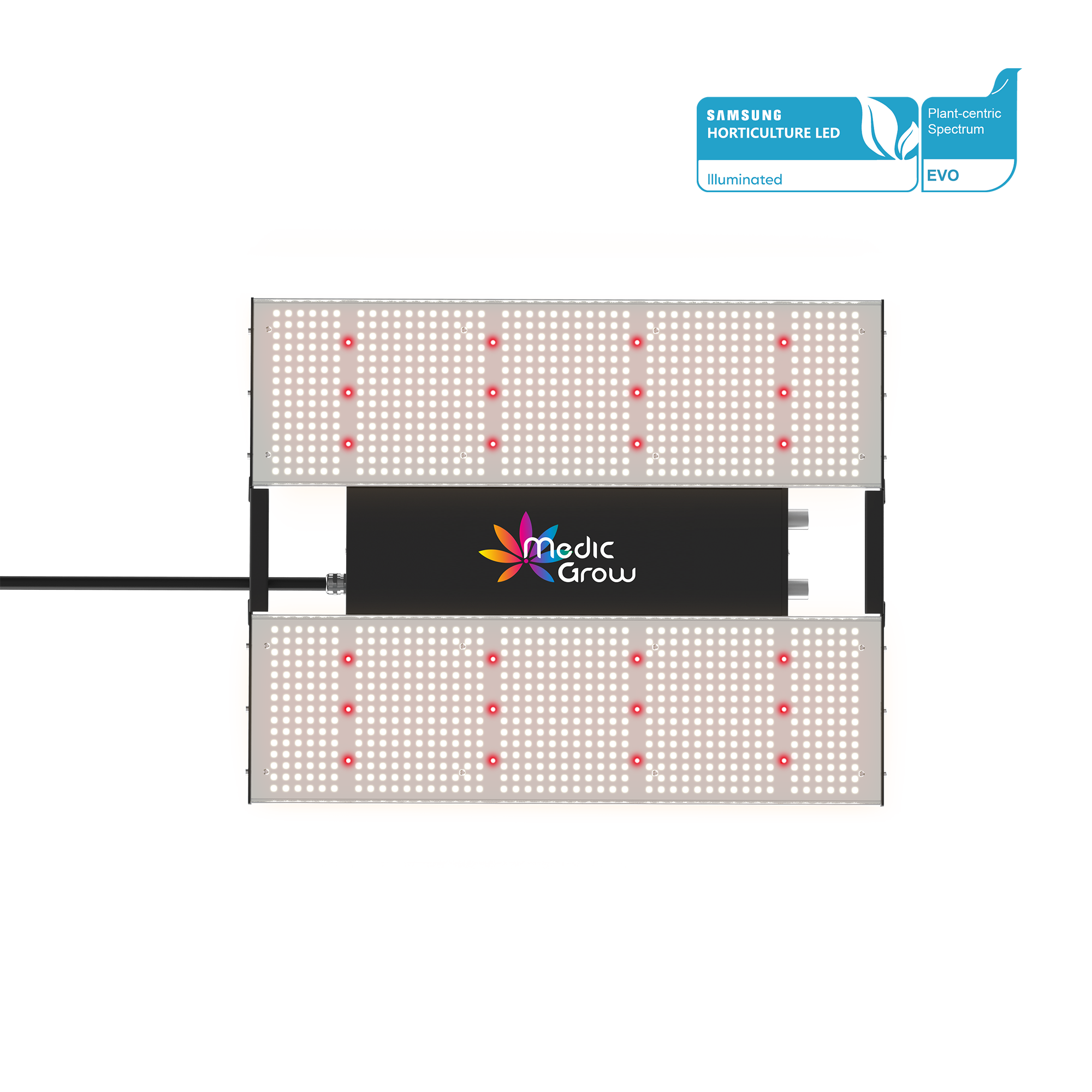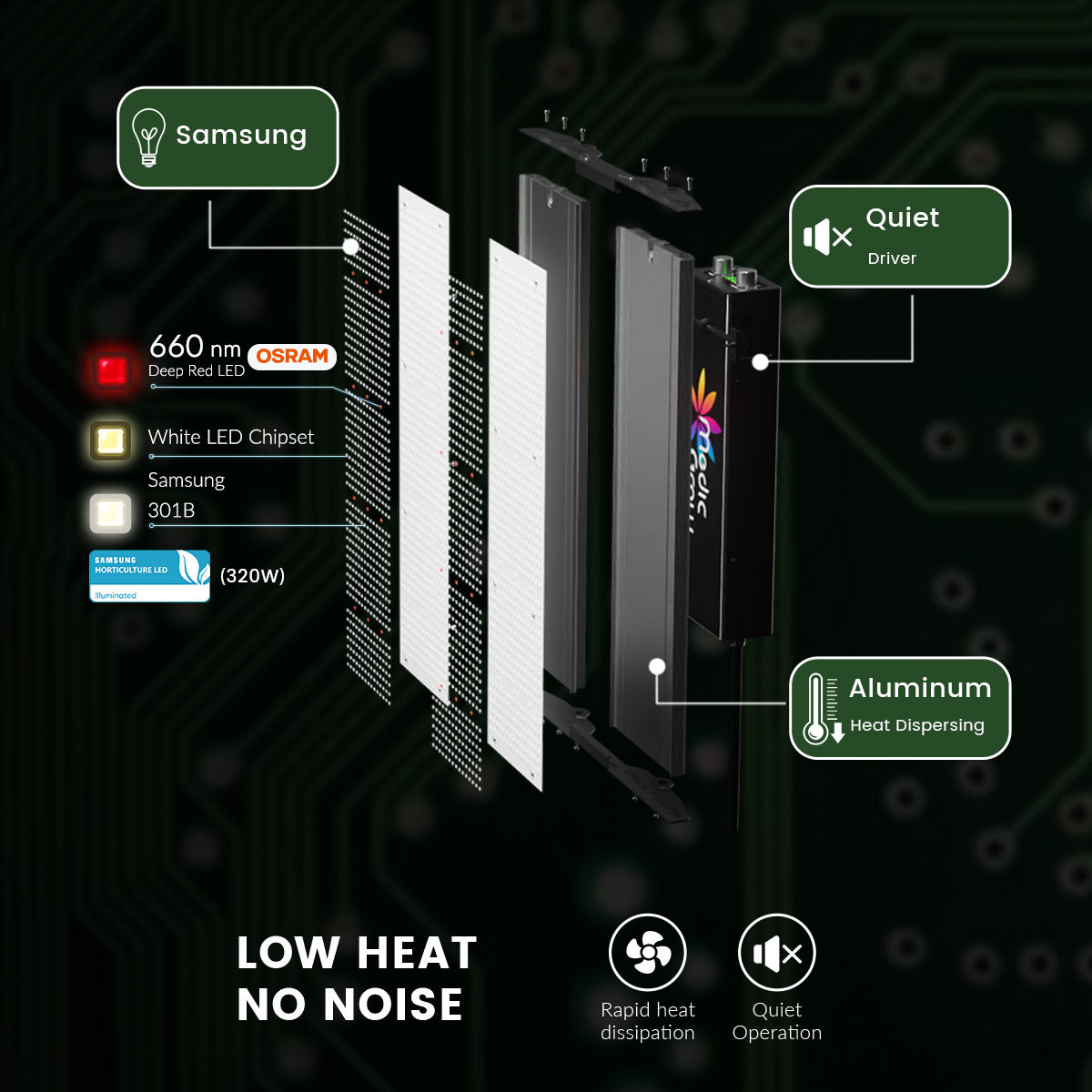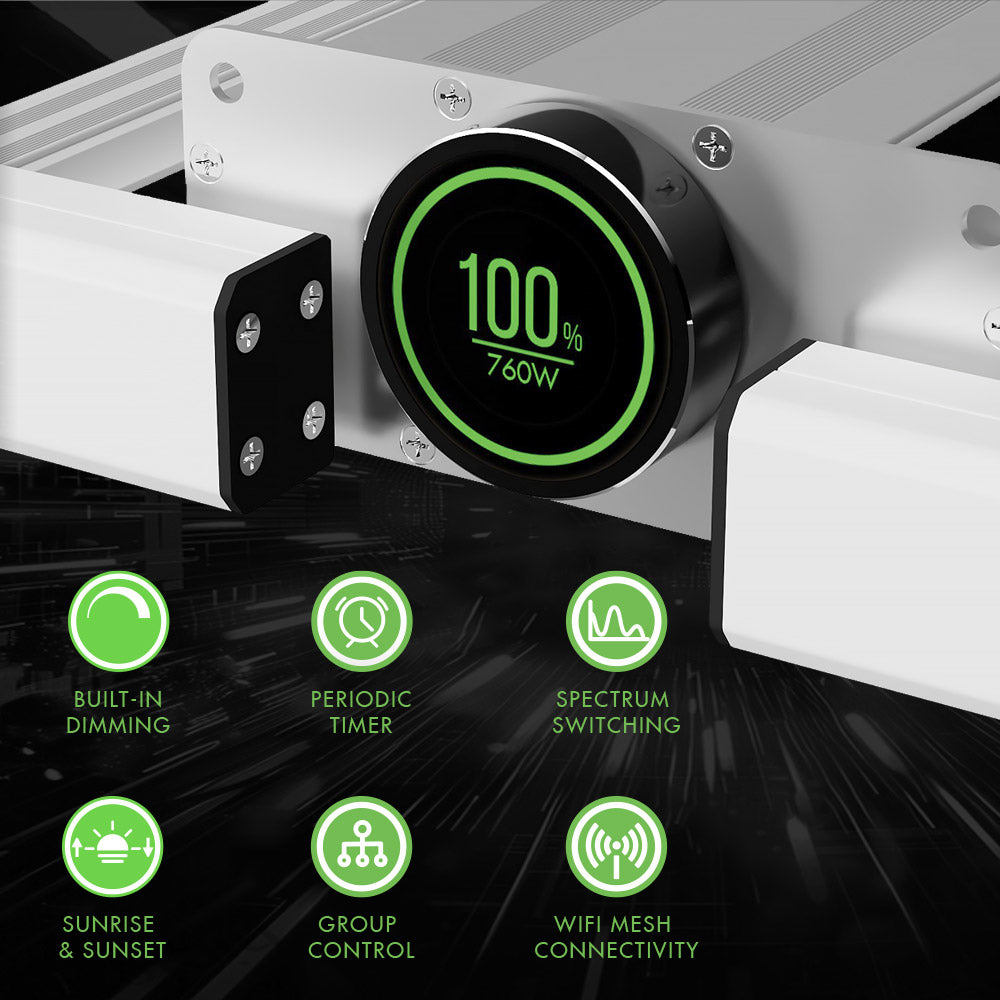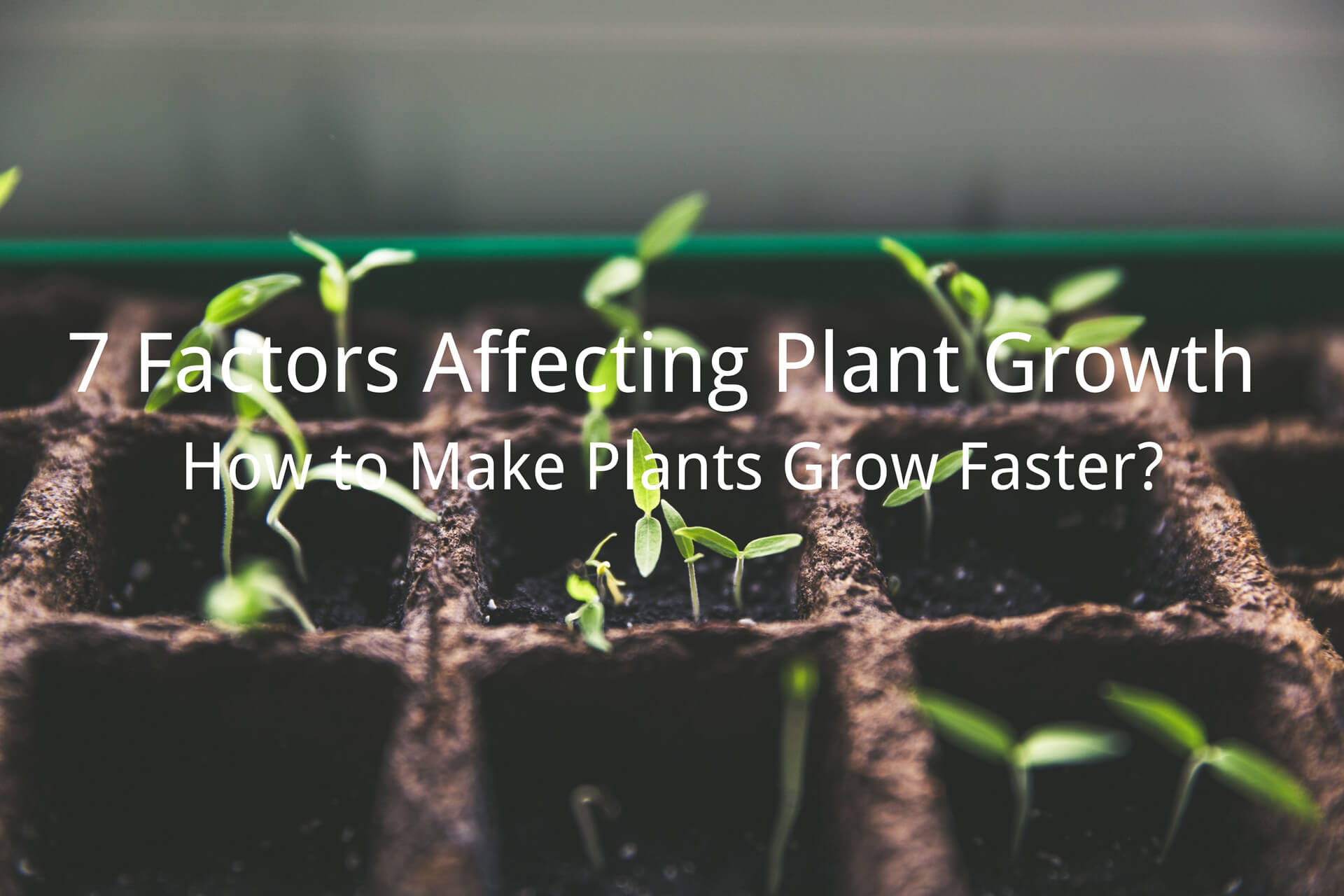
7 Factors Affecting Plant Growth - How to Make Plants Grow Faster?
When growers monitor plant growth, they realize that a ton of different factors come into play that help a plant achieve optimal health and have a high-quality yield.
These may include the ideal grow light, air, water, fertilizer, soil, protection from pests and insects, and much more.
In this article, we'll explore the different phases of plant growth and try to understand the role of environmental factors.
In the end, we'll leave you with some tips to help you with indoor growing.
Phases of Plant Growth
Naturally, plants absorb sunlight which contains all seven colors of the rainbow.
The chlorophyll that is present in the plants absorbs most colors of the spectrum but reflects shades of green and yellow and sometimes light blue which is why they are green or yellow.
There is no singular best color for plant growth but plants mainly absorb violet, blue, and red lights, therefore, they happen to be very important for the process of photosynthesis.

Plants have different phases of growth and need different amounts of light in each phase. In every phase, they may require different kinds of nutrients to grow and thrive.
Now, the stages of plant growth exist to help growers classify these plants and provide appropriate nutrients at the right time. Roughly, a plant goes through the following plant growth stages:
1. Germination:
This stage is where the seed germinates and turns into a sprout. When the water enters the seed, it activates the enzymes present inside it.
This is where the lifecycle of the plant begins.

2. Seedling:
As the plant's roots are developed to reach the water underground, it gets all the nutrients it needs to grow and eventually turns into a thriving plant.
Typically, blue light is effective during this stage of the plant growth.

3. Vegetative:
During this stage, plants need high amounts of nitrogen which offers them resources for new cells.
This stage can last for a few days, a couple of weeks, or months, depending on the kind of plant you choose to grow.
For instance, tomatoes typically have a duration of two weeks or 14 days.

4. Bud Formation:
Also known as budding, this stage is when the buds start to form. It may be important to add budding-specific fertilizers during this stage to provide your plants with appropriate nutrients.
Providing your plants with phosphorus during this stage can help with improved flowering.
During the fruiting stage of the plant, phosphorus is transported to the fruiting parts to make up for the high energy requirements.

5. Flowering:
Finally, the flowering stage which is also called the blooming or fruiting stage arrives.
During this stage, the plant develops flowers and fruits/vegetables. Red light is required by plants in this stage to aid with stem growth and height of the plant.

6. Maturity:
As fruits and vegetables grow ripe, the plant no longer requires the nutrients.
For instance, this is when a tomato turns from small and green to a juicy and ripe tomato.

To keep things easier, growers may divide their plant growth chart into three stages: The germination stage, the Vegetative stage, and the Flowering stage.
As you may have noticed, the aforementioned stages are much more detailed but the overall pattern remains the same.
In the next section, let's explore the environmental factors affecting plant growth.
Environmental Factors Affecting Plant Growth
A lot of environmental factors affect plant growth, development, or distribution.
The deficiency or excess of sunlight or water and the presence of insects, pests, or diseases can prevent the proper growth of the plant or affect the overall outcome.
Before you start growing plants, you need to understand exactly what you're doing. Indoor gardening requires individuals to replicate the environment that plants typically find outdoors.

Image Source: kcpc.org
So, for instance, a plant that grows in a tropical environment would need the same environment in a grow room.
This means focusing on aspects such as temperature and humidity and altering them to meet the plant's requirements.
These are the seven primary environmental factors affecting plant growth:
- Light
- Temperature
- Dormancy
- Water
- Humidity
- Fertilizers
- Nutrient absorption
Let's start by exploring one of the most important factors: Light.
How Does Light Stimulate Plant Growth?
As you may have studied in an environmental science class back in school, light is food for plants.
Plants convert light, water, and oxygen into energy, which is used by them to grow. Therefore, to have a strong structure and plant growth, they require light.
Over the years, researchers have found a way to replicate sunlight by providing plants with colors that they require from the spectrum.
As you may have noticed, LED growing lights have been gaining popularity among indoor growers because they're cost-effective and efficient.
An LED grow light is a light for plant growth. Even though it cannot replace sunlight, it is a suitable alternative for those who wish to grow plants indoors.
Growers who live in areas with colder temperatures can easily grow fruits and vegetables indoors in grow tent kits or grow rooms, despite not having a favorable outdoor environment.

Image Source: greenhousetoday.com
However, there are a few things that you need to keep in mind while installing grow lights such as the intensity of the light or the distance between the plant canopy and the light source.
LED grow lights, such as the 150-watt grow light for house plants, are used to mimic sunlight - growers keep them on for a specific duration and turn them off so that the plants think it is nighttime.
This process triggers plant growth and eventually, it results in budding and blooming.
Growers who have been growing crops for a while would agree that it is not that simple: they need to keep in mind the duration, intensity, distribution, and other aspects of light to have high-quality produce.
- Light Intensity:
The intensity, which refers to how concentrated/intense the light is, determines the plant's capability to have a high yield.
If the light is abundant in quantity and is intense, its capacity to produce its food would increase, leading to an increase in energy.
In modern LEDs like grow lights 1000 watt, the intensity of the light can be altered to meet the different needs of a plant.
For instance, certain plants may need more light to trigger flowering so, by increasing the intensity, one can ensure that the plants achieve optimal health.
- Wavelength:
As discussed earlier, different colors of light are required by the plants in different phases.
The main photosynthetic pigments that are present in plants primarily absorb red and blue wavelengths of light:
Blue light encourages growth in the vegetative stage of the plant while when it is combined with red, it encourages blooming in the plant.
Green and yellow wavelengths of light have minimal effects on plants.
- What is the 'Photoperiod'?
The 'photoperiod' is the period where plants receive light. It refers to the recurring phase of day and night (i.e. light and dark) that affects plants and other organisms.

Plants react and respond to this period in their unique ways. Some plants respond under specific day lengths.
Plants can be divided into three categories based on their day lengths:
- Short-day: these are plants that flower when the day length (time of light) is less than 12 hours.
- Long-day: these are plants that flower when the day length is more than 12 hours.
- Day-neutral: these are plants that flower regardless of the day length.
How Does Temperature Affect The Plant?
Temperature plays a significant role in plant processes and when it increases and reaches a specific point, photosynthesis, respiration, and transpiration increase too.
In the case of flowering plants, it can help them move from one stage to another.
Harsh weather conditions that are too hot or too cold for the plant can stunt its growth or kill the plant altogether.
The temperature of the soil also affects plant growth, albeit indirectly, by affecting the water and nutrient usage of plants.
Low daytime temperatures can prevent the plant from growing at the optimal speed.
- Effect Of Temperature On Germination Stage
Temperature and moisture directly affect germination.
There's no perfect 'temperature' guideline that can be applied to every plant as different varieties may germinate at different temperatures.
For instance, tomatoes require a warmer room temperature to germinate. As per the University of California Cooperative Extension, Sacramento County, they require a soil temperature of at least 50°F to germinate.
- Effect Of Temperature On Flowering Stage
Likewise, temperature also affects flowering or blooming.
Some plants require a shift in temperature to trigger blooming. Orchids, for instance, require a 10 -15° drop.
Depending on whether the plant naturally grows in a cool, intermediate, or warmer, growers alter the grow room temperature to allow their flowers to bloom.
- Effect Of Temperature On Quality Of Produce
Temperature can affect crop quality and even hinder the development and ripening of some fruits and vegetables. It may even affect the overall agricultural productivity.
Increased temperatures may decrease pollen production which in turn leads to reduced fruit and seed set and other undesirable outcomes.
Additionally, high temperatures can cause heat damage to the plant and burn the leaves, roots, and other parts of the plant.
This is why it is important to adjust the temperature of your grow tent and check for proper air circulation.
How Dormancy Affects Plant Growth
A majority of perennial plants go into a state of dormancy during colder months. This means that they conserve their energy for the next bloom.
Beginners may think that the plant is dead and end up throwing it or replacing it with another plant.
After this period of dormancy, the plant can be revived by giving it food, indirect sunlight, and fertilizer.
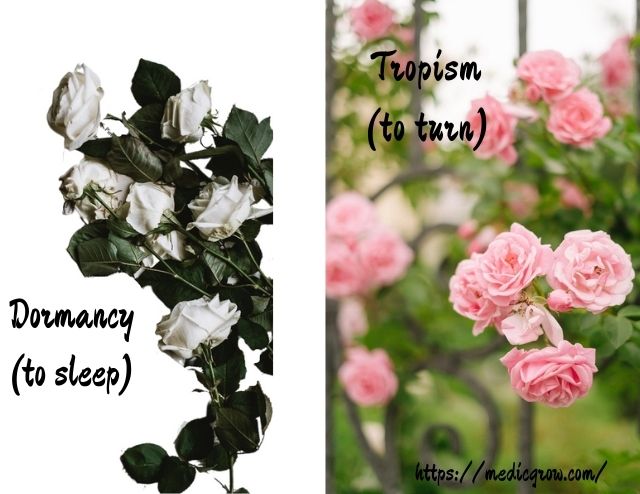
Why Water Matters in the Growing of Plants
Water is food for the plants and it is used by plants as a medium to carry nutrients from the soil. It helps the plants to convert starch into sugar.
Excess water and the deficiency of water are both harmful to the plant.
Excess water can lead to root rot and kill the plant while its deficiency can prevent the growth and development of the plant.

Humidity Also Means a lot in Plants Growing
When there's adequate moisture or humidity in the environment, plants can thrive. This is why plants often die in winter because of the lack of moisture.
Most indoor plants are accustomed to living in humid environments but may succumb if the humidity reaches beyond a certain point.
However, plants such as Pineapple may even thrive in high-humidity environments.
Are Fertilizers Plant Food?
Even though the words 'fertilizers' and 'plant food' are used interchangeably, they are very different from each other.
Fertilizers can be called supplements and are needed in different amounts by different varieties of plants.
Fertilizers should be used carefully and must be diluted to ensure that the roots are not affected.
Some growers tend to use 'plant growth regulators' to alter plant growth as they deem fit. They are used to either stimulate or block certain enzymes to affect the flowering, branch growth, fruit drop, etc.
What Affects Nutrient Absorption In Plants?
Nutrient absorption can be affected by many things.
A possible explanation why your plant may not be growing well is that it cannot find the nutrients that it needs in the soil that it is growing or that the nutrients that are currently present in the soil are of no use to the plant.
Taking care of these needs would solve a majority of your problems.
In the next section, we'll look at some tips for growers.
Tips for Growers
There's not much that you can do when you're growing crops outdoors since it is hard to control the environment.
But when it comes to indoor growing, it is much easier to take care of them.
- Start small
First and foremost, it is important to ensure that your growing area is only as big as you can handle.
Beginners need to see how a plant responds to the nutrition (fertilizer, water, light, etc.) before proceeding further.
Start by understanding the plant growth chart of the plant that you're about to grow.
Once you've grown a crop, it is much easier to predict how it will react in the future when planted in a bigger batch.
So, start small with a tiny batch of plants in the canopy and level up when you think you're confident enough to handle a bigger size.
- Invest in good-quality equipment and materials
Investing in good quality lights, seeds, fertilizer, grow tents, grow lights, etc. is a must if you want an excellent yield.
Choose full spectrum grow lights that offer wavelengths of all colors of the spectrum rather than a few colors so that plants can get the most out of them.
- Know the difference between fertilizer and nutrition
Fertilizers are like supplements that aid plant growth, but they are not plant food.
Plants require light, water, and carbon dioxide to make their food.
Just as we, humans, take supplements to make up for any nutrient deficiencies, fertilizers are used to ensure that plants can get all the required nutrients from the soil.
Make sure to always get your soil tested to see the nutrients present in it instead of guessing it on your own.
- Manage stress
Factors that cause 'stress' to the plants such as unbearable temperatures, excess water, pests, insects, or nutrient deficiencies can also prevent the plant from growing well.
So it is important to manage stress in plants to encourage plant growth.
Conclusion
Overall, growing plants indoors is a really simple and fun activity, and when you know exactly what you're doing and the effect that it will have on your plants, it makes the process much easier.
Related Posts:
When Should You Replace Your Grow Light Bulbs?
Featured Products
Blog Posts
Contact Us with Any Idea!
- Choosing a selection results in a full page refresh.
!















